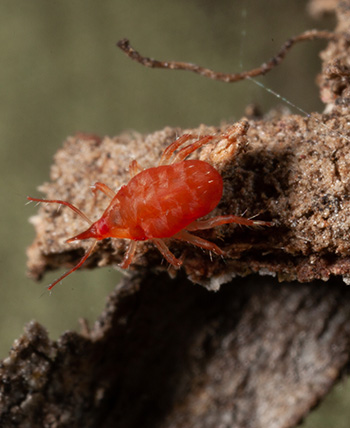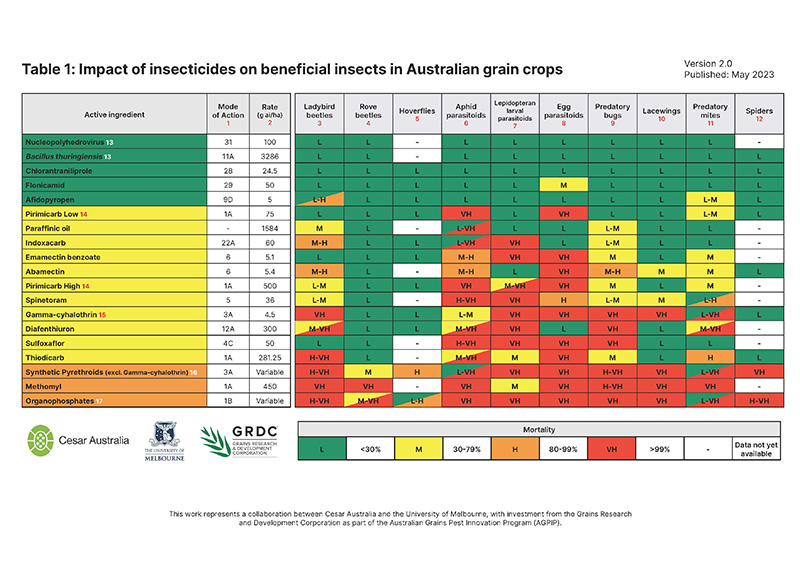Paddock Practices: Pest control with precision – the Beneficials Chemical Toxicity Table, a decision-support tool
Paddock Practices: Pest control with precision – the Beneficials Chemical Toxicity Table, a decision-support tool
Date: 24 Jan 2024

Key points
- Insecticides, especially broad-spectrum, can harm beneficial insect populations, limiting their role in natural pest suppression.
- Integrated pest management (IPM) aims to address pest issues holistically. Understanding chemical toxicity is essential for informed decision-making that balances effective pest control with minimal harm to beneficial species.
- The Beneficials Chemical Toxicity Table categorises insecticides based on their chemical toxicity to beneficial insects, aiding growers and advisers in selecting insecticides that align with IPM principles.
- For easy interpretation, the table employs a color-coded system for toxicity ratings: green indicates low impact, yellow moderate impact, orange high impact and red very high impact.
- The table helps prioritise insecticides with the lowest overall toxicity for a range of beneficial species and assists in choosing the least toxic options for targeting specific pest problems (e.g. aphids and aphid parasitoids).
Each season, growers and agronomists face important choices in how to best manage pests.
Insecticides are a crucial tool, yet there is an increasing dialogue about the significance of beneficial insects, which play a vital role in keeping pest populations below economically damaging levels.
In the past, growers faced a difficult choice: preserve beneficial insects or resort to insecticides. However, the emergence of more selective insecticides has changed the landscape, making it possible to include their use as a sustainable element of integrated pest management (IPM) programs. The challenge, until recently, was the lack of knowledge about the varying impacts of different insecticides on the diverse beneficial insect populations.
The Beneficials Chemical Toxicity Table addresses this challenge. This tool was developed under the Australian Grains Pest Innovation Program (AGPIP), a collaborative investment by the Grains Research and Development Corporation (GRDC), Cesar Australia and the University of Melbourne. It serves as a practical resource for growers, supporting informed decisions about insecticide choice. By using this tool, growers can effectively protect their crops while simultaneously considering the impacts on beneficial insects.
Management issues
Insecticide use, especially those with broad-spectrum activity, like synthetic pyrethroids and organophosphates, can significantly harm populations of beneficial insects. This disruption can lead to secondary pest outbreaks, where previously controlled pests become problematic due to the removal of their natural predators from the environment. Essentially, when the beneficial insect populations are diminished, it paves the way for an influx of pests, leading to further complications in pest management.
Compounding the challenge is the evolution of pest resistance to some commonly used insecticides. This development has made controlling certain pest species, such as the redlegged earth mite and green peach aphid, increasingly difficult.
To tackle this dual challenge, growers are adopting strategies to bolster beneficial insect populations and reduce their reliance on the use of insecticides within their IPM programs. This holistic approach combines biological, cultural, and chemical methods to control pests, aiming for sustainable solutions. Understanding the impact of insecticides on insect diversity is crucial in IPM. It enables more strategic choices in insecticide usage that enhance, rather than hinder, beneficial insects.
The Beneficials Chemical Toxicity Table
First published in April 2022, the table provides a comprehensive overview of how various insecticides affect key groups of beneficial insects like ladybird beetles, parasitoid wasps, lacewings, and hoverflies. This resource, developed with contributions from growers and industry experts, focuses on the insecticide, field rates and pests pertinent to broadacre grain farming in Australia. The data is derived from a thorough review of studies on maximum field rates used in the Australian grains industry. To fill any identified knowledge gaps, researchers conducted laboratory bioassays, adhering to standards set by the International Organisation for Biological Control. In essence, extensive research was undertaken to understand the effects of insecticides relevant to grain crops on crucial insect populations here in Australia.
The table marked a pioneering development for Australian broadacre cropping and has been regularly updated since its launch to remain current and useful for growers. Dr Rosie Knapp and the team at Cesar Australia have been diligently refining and expanding the toxicity data. The most recent update, in May 2023, concentrated on snout mites, which are important predators of the red-legged earth mite and lucerne flea, and this data is now incorporated into the ‘predatory mites’ category. Current research efforts are focused on important generalist predators that predate a wide variety of pests, such as hoverflies and spiders, demonstrating a commitment to continuously improving the understanding of these beneficial species within the context of pest management.

Using the table: tips and tricks
For user convenience, especially when in the field, the table is organised with a clear and categorised layout.
Toxicity ratings are derived by averaging data sets from literature reviews and bioassays. The table is organised in descending order of toxicity, with the least toxic insecticides listed at the top, progressively moving down to the more toxic options. This format simplifies the process of identifying the most appropriate insecticides for use in various situations.
The impact ratings in the table are colour-coded for straightforward interpretation, akin to a traffic light system, indicating the level of impact on beneficial insects. The colour scheme is as follows:
- Green: low impact
- Yellow: moderate impact
- Orange: high impact
- Red: very high impact
- A diagonal slash: variable impact rating, reflecting a broad mortality range.
Using this system, green-rated insecticides are most supportive of beneficial insect populations. In contrast, opting for an insecticide in the red category, results in very high mortality of beneficial insects within that crop.
Targeted pest management
The table enables targeted spray decisions, balancing the need to control specific pests with the preservation of beneficial insects. To use it effectively:
- Identify specific pests: When leading with a specific pest, such as aphids, consult the table to find insecticides with low toxicity to beneficial insects linked with that pest. For instance, choose options that minimally impact aphid parasitoids, which are often crucial in suppressing aphids below economic thresholds.
- Preserve beneficial insects: This targeted approach allows the pest problem to be addressed whilst preserving beneficial insect populations that have been identified with the crop, thereby reducing secondary pest outbreaks later in the season.
- Consider generalist predators: In cases where monitoring of beneficial insect populations is difficult, prioritise insecticides with the lowest overall toxicity. Supporting generalist predators like rove beetles can have broad benefits for the farm ecosystem.
By focusing on insecticides that are least harmful to a wide range of beneficial insects, this method contributes to a healthier, more balanced agricultural system.
Empower your pest management strategy with the table
Using the table allows growers to harmonise their methods with IPM principles, enabling them to manage pests effectively and sustainably. As a crucial tool in sustainable pest management strategies, it assists growers in finding the optimal balance between effective pest control and the preservation of vital beneficial insects. This informed, targeted approach is key to maintaining both crop health and environmental sustainability.
Acknowledgements
This research is being undertaken as part of the Australian Grains Pest Innovation Program (AGPIP). AGPIP is a collaboration between the Pest & Environmental Adaptation Research Group at the University of Melbourne and Cesar Australia. The program is a co-investment of the Grains Research and Development Corporation (GRDC) and the University of Melbourne, together with in-kind contributions from all program partners.
Thanks to Rosie Knapp (Cesar Australia) for technical inputs when developing this Paddock Practice and her work in leading the project, and thanks to Jacquie Murphy (Cesar Australia) for her assistance in creating the table.
Further resources
Beneficials Chemical Toxicity Table (Cesar Australia website)
GRDC Podcast: Beneficials Chemical Toxicity table: Use it or lose ‘em
GRDC Podcast: Natural enemies: beneficials, insect friends with benefits
GRDC Update Paper: Minimising the impact of insecticides on beneficials in broadacre crops
GRDC Media Release: Understanding chemical impact on beneficial insects in grain paddocks
More information
Rosie Knapp
Cesar Australia
rknapp@cesaraustralia.com
GRDC Project Code: UOM1906-002RTX,
